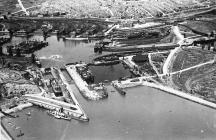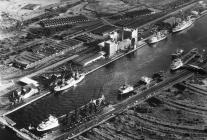Content can be downloaded for non-commercial purposes, such as for personal use or in educational resources.
For commercial purposes please contact the copyright holder directly.
Read more about the The Creative Archive Licence.
Description
Aerial view of Cardiff Docks, June 1947.
The Glamorganshire Canal of 1798 brought iron from Merthyr Tydfil for export through the then small port attached to the village of Cardiff. Cardiff expanded rapidly from the 1830s onwards and became the main port for exports of coal from the Cynon, Rhondda, and Rhymney valleys, growing at a rate of nearly eighty per cent each decade between 1840 and 1870. To meet the increased demand for shipping facilities the Bute West Dock was opened in 1839, enclosing 7.7ha of water; it is now filled in and built over and the entrance basin is the Roald Dahl Plasse and a public space. Bute East Dock opened in 1859 and eventually enclosed 18.2ha; much of this survives as an isolated stretch of water, with a bonded warehouse at its north end. The docks continued expanding with the Roath Basin, Roath Dock in 1887 and finally the Queen Alexandra Dock twenty years later. These parts of the dock are still in use commercially and the dock structures themselves are important historic features. In 1888 the docks were transferred from the Bute Estate to the Bute Dock Co. and then, in 1897 to the Cardiff Railway Co. A result of this was the pierhead building of 1896, alongside the West Dock Basin, which housed the dock offices. To the west of the pierhead is Mountstuart Square where shipping and coal companies had their offices. Much has been demolished but the centre of the square is occupied by the Coal Exchange, now used for functions, although its trading floor remains. In this area are the Custom House, Pilotage Building, a hydraulic accumulator station, graving docks and the Norwegian Church.






Do you have information to add to this item? Please leave a comment
Comments (0)
You must be logged in to leave a comment